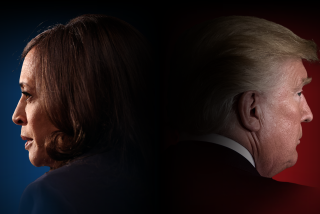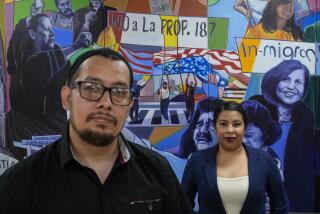Sizing Up a Personâs Future in 3 Minutes
MEXICO CITY â U.S. consular officer Doni Phillips peers through thick glass at six Mexican family members, from a 70-year-old grandfather on crutches to a 9-year-old boy, and ponders.
The simple question she and her colleagues here at the busiest U.S. consulate in the world try to answer all day long: Will these people come back--or will they try to stay in the United States?
Phillipsâ rulings on the scores of visa applicants she interviews each day will affect far more than family reunions, business trips and long-planned vacations. They will also help determine the pattern of immigration in the United States.
Given that 41% of illegal immigrants in the U.S. entered on legitimate visas and then outstayed their welcome, Phillipsâ yea or nay could have an impact on American demographics for years to come.
These relatives want to travel together on a summer holiday. The grandfather holds a crumbling passport issued in 1950, had once worked north of the border as a laborer and on several trips had returned to Mexico in compliance with his visas. So Phillips gives him a 10-year, multiple-entry visa.
She worries about the children, though--but she doesnât want to wreck the familyâs plans. So she makes a compromise ruling: single-entry visas for them, good for just one trip.
âYou just never know how good your decisions are, because you never know who comes back,â said Phillips, who hails from tiny Fromberg, Mont., but has been in the giant metropolis of Mexico City for 18 months.
There have been enormous changes in recent years in the way the U.S. Consulate in Mexico City handles a huge daily volume of applicants.
Lines of applicants used to snake around the block. Sullen hopefuls began gathering at dawn; a few even camped on the sidewalk. Radio news shows gave helicopter reports of the human traffic jams at the vast, dark âvisa barn.â
Not anymore. The lines are gone, and the usual wait has been cut from a full day to an hour or two for the more than 400,000 people who will be interviewed this year for tourist and other non-immigrant visas. Thatâs about 2,200 face-to-face encounters a day, now conducted with customer-friendly efficiency through a âjust in timeâ reservation system that rivals that of any private-sector business.
Yet despite the high-tech advances at the re-dubbed âvisa pavilion,â consular officials agree that the task of the visa interviewer remains the same as it was decades ago.
âUltimately, it comes down to a judgment,â said Robyn Bishop, minister counselor for consular affairs in Mexico, who processed her first visa application 28 years ago. âDoes the officer think the person is going for legitimate travel reasons, on a temporary basis?â
Not far from where Phillips was working, Vicente Montes and his wife, Amalia Flores, walked dejectedly from the hall with their toddler grandson. Flores was near tears and her husband pained and angry. All three had been turned down.
The couple said they had wanted to visit their daughter, the boyâs mother, in Colorado during the summer. The refusal, they were told, was based on the risk that the boy would stay with his mother.
Consular officers spend three minutes on average grilling applicants and then say yes or no, on the spot.
First-Time Applicants Have the Longest Odds
About 30% of the non-immigrant visa applications are rejected, and first-time applicants are rejected more than half the time.
âWhen I first started, it felt overwhelming to make these decisions,â said Gabriel Kaypaghian, 33, from Saratoga, Calif., whoâs on his maiden foreign service tour. His first day, he handled fewer than 50 interviews. Now, he routinely does more than 100, or about 20 during each of the five hours the consulate sees applicants.
How does he decide?
âPeople tell you things. . . . One woman said she was a chief financial officer for a company, but then she didnât know the answer to basic questions. The right questions lead you to the reality,â Kaypaghian said.
But he added: âItâs definitely stressful, especially if you feel you made a wrong decision. . . . The times Iâve had regrets are when people maybe should have gotten a visa. Maybe they were too nervous, or said too much.â
Visa section chief Paul Doherty, who completed his tour this month, said consular officers go through tough, six-week training courses in Washington to standardize their decision-making and learn how to spot fraud. He said the team of about 25 Americans and 50 Mexicans also constantly looks for time-saving shortcuts. Colleagues give Doherty credit for many of the innovations.
âBefore, the line went around the corner, people brought blankets, and it was noisy inside because the children were hungry,â said Ofelia Perez Alejandre, a grandmother who had just been given 10-year visas for herself, her daughter and two grandchildren for a trip to Niagara Falls and New Jersey.
âCoyotes used to sell places in line,â Perez said, using the nickname generally applied to people who smuggle illegal immigrants into the U.S.
Phone-In System Eases Long Lines
A telephone system has ended the long outdoor lines. Applicants call a 900 number to get information and make an appointment, at a cost per call of $4 to $5. They are urged not to appear more than 15 minutes before their scheduled arrival. People pay the $45 application fee ($13 for those 14 or younger) beforehand at a bank, eliminating cash transactions at the consulate. Whether a visa is approved or rejected, the fee is nonrefundable.
One recent day, those with appointments gathered beneath a metal awning shading a nearly blocklong platform on which people could fill out applications. Coordinators in blue track jackets shouted instructions and offered assistance.
Inside, reception staff checked passport details to confirm that each person turning up had made an appointment. To prevent anyone from jumping the queue, they also assigned each applicant a number, which was flashed on boards overhead as a summons to each subsequent step of the process.
Next, State Department personnel scanned in data from the applicantsâ passports and took digital photos and fingerprints, all in less than a minute.
After having their documents inspected by officials trained to spot forgeries, applicants moved on to the most nerve-wrenching aspect of the exercise: the interview at one of the 15 windows arrayed along a wall of the pavilion.
Only U.S. consular officers can conduct the actual interviews--to avoid the risk of undue pressure on local staff.
Before the electronic queuing system was installed, applicants sat on benches and literally slid along them until their turn came for an interview.
But the benches have been replaced by comfortable chairs. A Lego play area brightens the interview hall, and piped-in classical music soothes anxious applicants.
Phillips, the consular officer, said she had denied about 25% of the applicants she saw that day.
âIâm probably a little softer than a lot of the people on the line, but it evens out,â she said.
Four staffers field calls challenging visa refusals and requesting emergency consideration of applications. They will entertain appeals sent by fax, and occasionally rejections are overturned, said Rebecca Varner, deputy non-immigrant visa chief for administration.
The visa volumes are huge in U.S. consulates throughout Mexico--not surprisingly, given that there were 320 million legal crossings of the U.S.-Mexico border last year.
The nine consulates scattered around the country are all among Americaâs 15 busiest, said Bishop, the minister counselor for consular affairs, and they see a total of 2.1 million visa applicants annually. Adding to the volume, more than 2 million old-style border crossing cards--known as micas, short for the Spanish word for âlaminatedâ--will expire Sept. 30. They are being replaced by 10-year, credit card-size âlaserâ tourist visas, which are scannable and virtually forgery-proof. Visitors can enter for up to six months at a time.
Bishop noted that only the consulate in Seoul issues more visas than the one in Mexico City but that the Seoul office sees only a third of applicants personally. In Mexico, all applicants 7 or older are interviewed personally, giving Mexico City by far the most interviews.
And the numbers have risen fast. Doherty said that when he arrived three years ago, about 325,000 applicants were interviewed here, compared with âwell over 400,000 this year.â He attributes the increase to the improved service and the healthier Mexican economy, as well as to the imminent replacement of the micas.
Because Mexico and the U.S. share a 2,000-mile land border, most Mexicans migrating illegally continue to cross without papers; only about 16% arrive with legal visas and stay beyond their allotted time, according to the Immigration and Naturalization Service. But Mexico accounts for a whopping 54% of all the illegal immigrants in the U.S., so even a small proportion of visa-holders who overstay adds up to tens of thousands of people a year.
Visa Approval Provides âMore Than Tourismâ
The Mexico City consulate isnât quite Ellis Island, since only non-immigrant visas are handled here. Immigrant visa applications are processed in the northern city of Ciudad Juarez, across the Rio Grande from El Paso.
Still, the smiles that burst onto the faces of those told they will get a visa--making possible a visit to a relative or a long-coveted holiday--reveal how much can hang in the balance.
âEven though itâs only a tourist visa, itâs to visit a neighboring country, so itâs more than tourism--there are such strong family ties,â said visa officer Kaypaghian. âThereâs a lot at stake in getting to this window for a couple-minute interview.â
More to Read
Sign up for Essential California
The most important California stories and recommendations in your inbox every morning.
You may occasionally receive promotional content from the Los Angeles Times.










